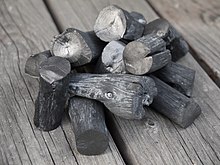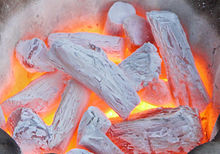Binchōtan


Binchō-tan (Japanese: 備長炭), also called white charcoal or binchō-zumi, is a type of charcoal traditionally used in Japanese cooking. Its use dates to the Edo period, when, during the Genroku era, a craftsman named Bichū-ya Chōzaemon (備中屋 長左衛門) began to produce it in Tanabe, Wakayama. The typical raw material used to make binchō-tan in Japan is oak, specifically ubame oak, now the official tree of Wakayama Prefecture. Wakayama continues to be a major producer of high-quality charcoal, with the town of Minabe, Wakayama, producing more binchō-tan than any other town in Japan.
White charcoal is made by pyrolysing wood in a kiln at ~240°C for 120 hours, then raising the temperature to ~1000°C. Once carbonised, the material is taken out and covered in a damp mixture of earth, sand and ash.[1] Little is known about the structure of this form of charcoal.[1]
There exists a common misconception amongst restaurants and chefs when promoting the use of binchō-tan, when they mistakenly refer to oga-tan, a form of compressed sawdust charcoal, as binchō-tan. To differentiate the aforementioned "non-pure" products, there is a movement to call binchō-tan produced in Wakayama Kishū binchō-tan (紀州備長炭), Kishū being the old name of Wakayama.
Binchō-tan is a type of lump charcoal or hardwood charcoal, taking the shape of the wood that was used to make it. Binchō-tan is harder than black charcoal, and rings with a metallic sound when struck. Wind chimes and a musical instrument, the tankin ("charcoal-xylophone"), have been made from it.
References[]
- ^ Jump up to: a b "Microstructural Characterization of White Charcoal". Journal of Analytical & Applied Pyrolysis. Retrieved 29 April 2020.
External links[]
| Wikimedia Commons has media related to Binchotan VietNam. |
- 紀州備長炭 —Making of Kishū Binchōtan by Wakayama Pref.
- 炭琴 —Tankin ("charcoal-xylophone")
- "Charcoal Adds to the Good Life" – an article from 2001 touting the benefits of black and white charcoal, the latter including binchōtan
- Allotropes of carbon
- Fuels
- Japanese cuisine
- Japanese culture
- Charcoal